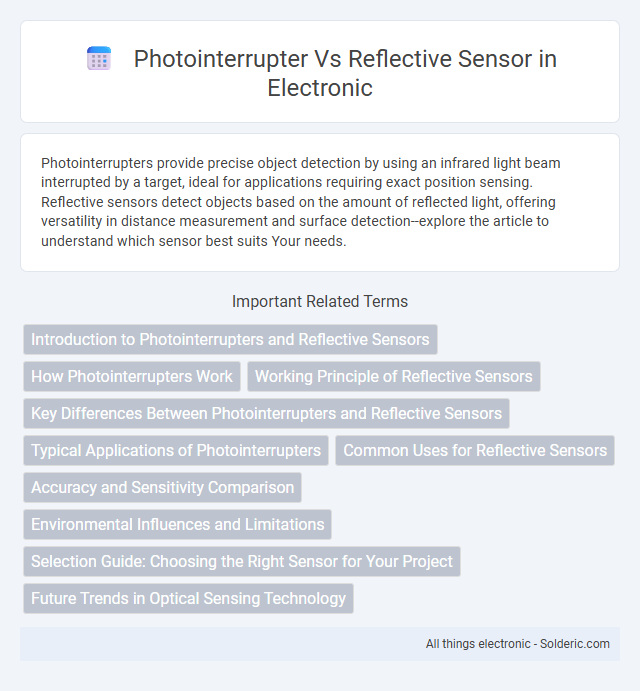Photointerrupters provide precise object detection by using an infrared light beam interrupted by a target, ideal for applications requiring exact position sensing. Reflective sensors detect objects based on the amount of reflected light, offering versatility in distance measurement and surface detection--explore the article to understand which sensor best suits Your needs.
Comparison Table
| Feature | Photointerrupter | Reflective Sensor |
|---|---|---|
| Working Principle | Light beam interruption between emitter and detector | Light reflection from target surface back to sensor |
| Detection Range | Typically short, fixed gap | Variable, depends on reflectivity and distance |
| Applications | Object presence, position sensing, limit switches | Proximity detection, color sensing, surface detection |
| Mounting | Requires alignment of emitter and detector opposite each other | Emitter and detector integrated on same side |
| Output Type | Digital (on/off) | Analog or digital depending on sensor design |
| Environmental Sensitivity | Less affected by ambient light | More sensitive to ambient light and surface conditions |
| Common Models | TT Electronics OPB, Sharp GP1A | Sharp GP2Y0A, Vishay TCRT5000 |
Introduction to Photointerrupters and Reflective Sensors
Photointerrupters are optoelectronic devices consisting of an infrared LED and a phototransistor positioned opposite each other to detect the presence or absence of objects by interrupting the light beam. Reflective sensors, on the other hand, use a single infrared LED and photodetector configured to detect reflected light from an object's surface for proximity or positioning applications. Both sensors play crucial roles in automation, robotics, and industrial equipment for object detection and motion control.
How Photointerrupters Work
Photointerrupters operate by detecting the interruption of a light beam, typically infrared, between an emitter and a photodetector, enabling precise object detection and positioning. When an object passes through the gap between the emitter and sensor, it blocks the light, causing a measurable change in the photodetector's output signal. This direct interruption method provides high accuracy in applications such as rotary encoders, limit switches, and paper sensors.
Working Principle of Reflective Sensors
Reflective sensors operate by emitting a light beam, typically infrared, towards a target surface and detecting the reflected light intensity to determine the presence or distance of an object. The sensor's photodiode or phototransistor receives the reflected light, converting it into an electrical signal proportional to the reflectivity and distance of the object. This working principle enables reflective sensors to function without a receiver opposite the emitter, allowing for compact and versatile object detection in various applications.
Key Differences Between Photointerrupters and Reflective Sensors
Photointerrupters use an infrared LED and phototransistor positioned opposite each other to detect object presence by interruption of the light beam, offering precise object detection in a defined path. Reflective sensors emit infrared light from an LED and measure the reflected light intensity from an object, enabling detection without requiring the object to break a beam. Photointerrupters excel in applications requiring accurate edge or position sensing, while reflective sensors are preferred for proximity detection and surface reflectivity measurement.
Typical Applications of Photointerrupters
Photointerrupters are commonly used in applications requiring precise object detection and position sensing, such as printer paper feeders, automated assembly lines, and robotics for end-of-travel detection. These sensors excel in environments where a physical object interrupts a light beam, enabling reliable counting, speed measurement, and limit switch functions. Photointerrupters provide high-speed response and accurate detection in compact spaces, making them ideal for consumer electronics and industrial automation.
Common Uses for Reflective Sensors
Reflective sensors are widely used in object detection, position sensing, and proximity measurement across industries such as robotics, packaging, and automation. These sensors effectively detect surface presence and distance without direct contact, making them ideal for conveyor belt monitoring and paper edge detection in printers. Their reliability in distinguishing materials and colors enhances quality control processes in manufacturing environments.
Accuracy and Sensitivity Comparison
Photointerrupters offer higher accuracy and sensitivity in detecting object presence due to their direct interruption of the infrared beam, minimizing ambient light interference. Reflective sensors rely on reflected light intensity, making them more susceptible to surface color and ambient conditions, which can reduce detection precision. For applications demanding precise and consistent measurements, photointerrupters provide superior performance compared to reflective sensors.
Environmental Influences and Limitations
Photointerrupters perform best in controlled environments as they rely on an opaque object interrupting a beam, making them sensitive to dust, dirt, and ambient light interference, which can cause false readings. Reflective sensors detect changes in reflected light intensity, but their accuracy is compromised by varying surface colors, textures, and ambient lighting conditions such as sunlight or artificial light sources. Both sensor types exhibit limitations in harsh or dynamic environments, necessitating careful selection based on specific application conditions to ensure reliability and precision.
Selection Guide: Choosing the Right Sensor for Your Project
Photointerrupters offer precise object detection by interrupting a light beam, making them ideal for applications requiring accurate position sensing or edge detection. Reflective sensors detect objects based on light reflection, providing flexibility in non-contact proximity sensing and surface detection but may require calibration for varying materials. Consider your project's environmental conditions, detection range, and target object properties to select the sensor that best meets your accuracy and reliability needs.
Future Trends in Optical Sensing Technology
Emerging trends in optical sensing technology emphasize miniaturization, enhanced sensitivity, and integration with IoT devices, driving the evolution of photointerrupters and reflective sensors. Advances in semiconductor materials and AI-powered signal processing are enabling higher precision and energy efficiency in both sensor types. The shift toward smart manufacturing and autonomous systems is accelerating the adoption of hybrid optical sensors that combine the strengths of photointerrupters and reflective sensors for versatile applications.
Photointerrupter vs Reflective Sensor Infographic

 solderic.com
solderic.com